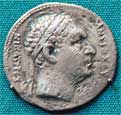
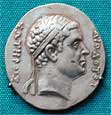
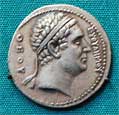
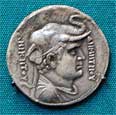
He placed on the coins images of his predecessors, in order: Seleucid king Antiochus II (266-246 BCE), Diodotus Soter (ca. 240), Euthydemus I (230-200 BCE), and Demetrius I (200-190 BCE).
The last of these shows the elephant headdress affected by Alexander the Great on some of his coins.

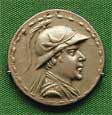

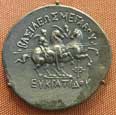
(1) and (2) Greek-Indian style bronze coins with Kharoshthi and Greek inscriptions, CM 1894.5-6.1030, CM 36 (India Office Collection); (3) Silver Greek-style coin; (4) and (5) Two Greek-style silver coins for use in Bactria, CM 1987.6-49.498; CM 1888.12-8.131.
Cf. for (1) and (2), American Numismatic Society, ANS 2000.7.140, weight 7.71 g., size: 21 mm. The image of the two horsemen on the reverse is the dioscuri (Casto and Pollux). For no. (3), cf. ANS 1997.9.177, weight 16.52 g.; dia. 31 mm.

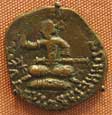
(2) Bronze coin of Azes I. CM 85 (India Office Collection).
Cf. for (1), American Numismatic Society, ANS 1944.100.63732, weight 9.43 g., dia. 28 mm., whose reverse shows a standing Zeus. Cf. for no. (2) ANS 1944.100.63372, weight 6.07 g., dia. 21 mm., a 5 chalkon coin probably minted at Taxila Sirkap.
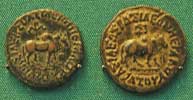
Cf. for coin on rt., American Numismatic Society, ANS 1973.56.964, a 6 chalkon coin minted probably at Taxila Sirsukh, weight 13.26 g., dia. 27 mm.; its obverse shows a lion. Another common variant of these coins wiht the humped bull is for the obverse to show an elephant.
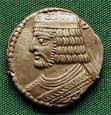
The reverse of such coins generally depicts the king enthroned, receiving either a crown or a palm from the goddess Tyche.
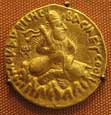
CM 1867.12-18.10
Cf. American Numismatic Society, ANS 1944.100.30161, weight 15.388 g.; dia. 25 mm.; on its reverse is an image of Shiva and a bull.
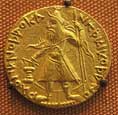
CM 1922.4-24.64
Cf. American Numismatic Society, ANS 1944.100.30746, weight 7.866 g., dia. 20 mm., on the reverse of which is an image of Oesho, as a four-armed Shiva.

CM 1894.5-6.39
Cf. American Numismatic Society, ANS 1944.100.63647, weight 7.925 g., dia. 21 mm., on the reverse of which is a standing Ardoksho. Of the several gold coins of Huvishka on the ANS site, this is the only one with the same crown, but overall the coin is not an exact match.
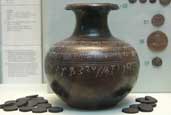


Found in 1836 in Buddhist stupa in the Wardak Valley, Afghanistan, some 48 km. west of Kabul, at the location of the monastery established by the donor Vagramarega. Dates from time of Kushan king Huvishka, ca. 126-163 CE. H.: 17.8 cm.
Contained 66 bronze coins, some of which shown here. They are from reigns of Vima Kadphises, Kanishka I and Huvishka. The Kharoshthi script inscription invokes blessings for the ruler Huvishka, the donor's mother, father (Kamagulya) and brother (Hashthuna Marega), and more generally his relatives, friends and associates.
OA 1880-93; CM 1979.2-15.21 to 41.
Learn more, but note the dating information on the website is not in accord with the captioning in the current display of the museum, which is what has been used here.


These coins are a prototype for Gupta coins. The reverse image (rt.) is that of the goddess Ardoksho enthroned.
CM 1893.5-6.34; 1894.5-6.11

CM BMC 2; BMC 3

He is wearing the crown of Anahita, Zoroastrian goddess of war and fertility. The reverse presumably depicts two figures flanking a fire altar.
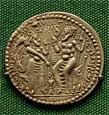
Shown worshipping Zoroastrian god Oesho.

Shown worshipping Zoroastrian goddess Anahita.

Minted at Bishapur, year 37.
Cf. American Numismatic Society, ANS 1940.209.1117, issued by Khusraw at Fars Darabjird, weight 3.84 g.; dia. 32 mm.; ANS 1954.203.197, minted at Marw, Khurasan, weight 4.09 g., dia. 31 mm.

The image on the obverse is that of Khusraw, on the reverse a fire altar with attendants.
There are several analogous coins in the American Numismatic Society collection for year 30, none for year 27.
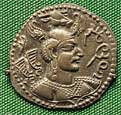
The reverse of these coins tends to show a fire altar.